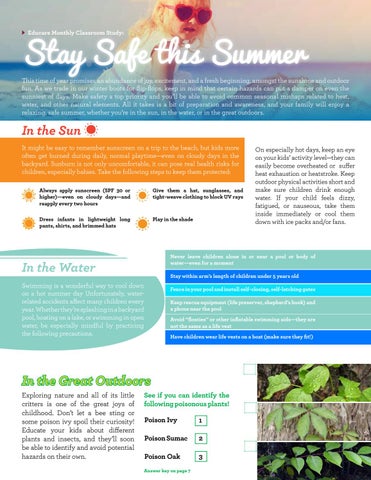Stay Safe this Summer Educare Monthly Classroom Study:
This time of year promises an abundance of joy, excitement, and a fresh beginning, amongst the sunshine and outdoor fun. As we trade in our winter boots for flip-flops, keep in mind that certain hazards can put a damper on even the sunniest of days. Make safety a top priority and you’ll be able to avoid common seasonal mishaps related to heat, water, and other natural elements. All it takes is a bit of preparation and awareness, and your family will enjoy a relaxing, safe summer, whether you’re in the sun, in the water, or in the great outdoors.
In the Sun It might be easy to remember sunscreen on a trip to the beach, but kids more often get burned during daily, normal playtime—even on cloudy days in the backyard. Sunburn is not only uncomfortable, it can pose real health risks for children, especially babies. Take the following steps to keep them protected: Always apply sunscreen (SPF 30 or higher)—even on cloudy days—and reapply every two hours
Give them a hat, sunglasses, and tight-weave clothing to block UV rays
Dress infants in lightweight long pants, shirts, and brimmed hats
Play in the shade
Never leave children alone in or near a pool or body of water—even for a moment
In the Water
Stay within arm’s length of children under 5 years old
Swimming is a wonderful way to cool down on a hot summer day Unfortunately, waterrelated accidents affect many children every year. Whether they’re splashing in a backyard pool, boating on a lake, or swimming in open water, be especially mindful by practicing the following precautions.
Fence in your pool and install self-closing, self-latching gates Keep rescue equipment (life preserver, shepherd’s hook) and a phone near the pool Avoid “floaties” or other inflatable swimming aids—they are not the same as a life vest Have children wear life vests on a boat (make sure they fit!)
In the Great Outdoors Exploring nature and all of its little critters is one of the great joys of childhood. Don’t let a bee sting or some poison ivy spoil their curiosity! Educate your kids about different plants and insects, and they’ll soon be able to identify and avoid potential hazards on their own.
On especially hot days, keep an eye on your kids’ activity level—they can easily become overheated or suffer heat exhaustion or heatstroke. Keep outdoor physical activities short and make sure children drink enough water. If your child feels dizzy, fatigued, or nauseous, take them inside immediately or cool them down with ice packs and/or fans.
See if you can identify the following poisonous plants! Poison Ivy
1
Poison Sumac
2
Poison Oak
3
Answer key on page 7
